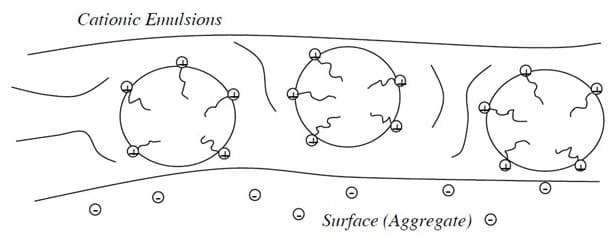The term cationic is derived from the migration of particles of bitumen under an electric field also. Because the droplets migrate toward the cathode (negative electrode), the emulsion is called cationic. As with anionic emulsifiers, the cationic emulsifiers operate similarly, causing the negatively charged head to float around in the water. This gives all of the droplets a positive charge. Positives repel each other, so all the droplets repel each other and remain as distinct bitumen drops in suspension. Below is a typical cationic emulsifying agent along with a diagram showing its orientation at the bitumen-water interface and the positive charge imparted to each drop.
Bitumen is dispersed in water in the continuous phase. As a result of the NH3 + group cover that surrounds bitumen droplets, the globules are positively charged and provide stability for emulsion by electrostatic repulsion. The bitumen droplets have an affinity for the negatively charged aggregate.
Bitumen and water-based solutions are processed under controlled conditions through a colloidal mill with a high-speed rotor in the presence of scientifically selected surfactants/emulsifiers. Choosing the right emulsifier & its quality is important for the stability, breaking, and curing of emulsions over aggregates.
The cationic emulsion is applied to a negatively charged surface by putting positively charged drops of bitumen on it. Drops of bitumen are immediately attracted to the surface and begin to break. Emulsions also lose water as they evaporate. Therefore, a cationic emulsion has two breaking mechanisms at work and will break faster than an anionic emulsion. Here is an illustration of the application:


The Cationic Bitumen Emulsion is chocolate brown and free-flowing at normal temperature. Once it breaks the bitumen breaks out and colour changes to black. An Emulsion is said to break when the organic and the aqueous phase separate into two distinct layers i.e. the dispersion ceases to exist. Emulsions are classified as Rapid Setting-1(RS-1), Rapid Setting-2(RS-2), Medium Setting (MS), Slow Setting-1 (SS-1), Slow Setting-2 (SS-2). The breaking time varies according to the designation of Emulsion although being largely dependent upon the climatic condition i.e. temperature, humidity, wind velocity, etc.
Where To Use Cationic Bitumen Emulsion?
The first emulsions were developed in the early 1900s. It was not until the 1920s however, that emulsions, as we know them today came to the fore due to their ecofriendly behaviour & other advantages, the use of Cationic Bitumen Emulsion has had a steady rise in demand worldwide. The INDIAN ROADS CONGRESS & MINISTRY OF ROAD TRANSPORT & HIGHWAYS have recommended the use of Cationic Bitumen Emulsion in several applications of Road Work like Tack Coat, Prime Coat, Surface Dressing work, 20 mm Premix Carpet, Sealing of cracks with fog seal, etc. Use of Cationic Bitumen Emulsion in SDBC Works is also under consideration & likely to get the necessary recommendation from MORTH & IRC shortly.
Why Use Bitumen Emulsion Instead Of Hot Bitumen?
The superiority of BITUMEN Emulsion originates from its basic characteristic i.e. used in Cold conditions which gives ease & efficiency in usage. We can use Bitumen Emulsion in varying weather conditions and almost in every type of Road Construction work, instead of the conventional cumbersome hot mix method.
Advantages of Cationic Asphalt Emulsion
- Because of the low viscosity of the Emulsion as compared to hot-applied Bitumen, The Emulsion has good penetration and spreading capacity.
- Bitumen Emulsion is electrically charged with built-in antistripping properties, which gives better bondage with hydrophilic aggregates mostly available in our country.
- It can be used even with wet aggregates thus enabling users to carry out work during the monsoon also.
- It does not need any pre-heating. This results in case of handling the user, besides saving in cost.
Cationic Emulsified Bitumen Specifications (AASHTO M208, ASTM D2397)
| Type | Rapid Setting | Medium-Setting | Slow-Setting | |||||||
|---|---|---|---|---|---|---|---|---|---|---|
| Grade | CRS-1 | CRS-2 | CMS-2 | CSS-1 | CSS-1h | |||||
| Min | Max | Min | Max | Min | Max | Min | Max | Min | Max | |
| Test on emulsions: | ||||||||||
| Viscosity, Saybolt Furol at 25°C SFS | 20 | 100 | 20 | 100 | ||||||
| Viscosity, Saybolt Furol at 50°C | 20 | 100 | 100 | 400 | 50 | 450 | ||||
| Storage stability test, 24-h, %B | 1 | 1 | 1 | 1 | 1 | |||||
| Demulsibility, 35 mL, 0.8% dioctyl sodium sulfosuccinate,% | 40 | ... | 40 | ... | ||||||
| Coating ability and water resistance: | ||||||||||
| Coating, dry aggregate Coating, after spraying Coating, wet aggregate | good fair fair | |||||||||
| Coating, after spraying | fair | |||||||||
| Particle charge test | positive | positive | positive | positive | positive | |||||
| Sieve test,%B | 0.10 | 0.10 | 0.10 | 0.10 | 0.10 | |||||
| Cement mixing test,% | 2.0 | 2.0 | ||||||||
| Distillation: | ||||||||||
| Oil distillate, by volume of emulsion,% | 3 | 3 | 12 | |||||||
| Residue,% | 60 | 65 | 65 | 57 | 57 | |||||
| Tests on residue from distillation test: | ||||||||||
| Penetration, 25°C, 100g, 5s | 100 | 250 | 100 | 250 | 100 | 250 | 100 | 250 | 40 | 90 |
| Ductility, 25°C, 5 cm/min, cm | 40 | 40 | 40 | 40 | 40 | |||||
| Solubility in trichloroethylene, % | 97.5 | 97.5 | 97.5 | 97.5 | 97.5 | |||||
Get in touch
Your Gateway to Top-Quality Bitumen
Elevate your projects with Gulf Bitumen’s superior quality and expertise. Contact us now to access top-notch bitumen solutions tailored to your needs.
